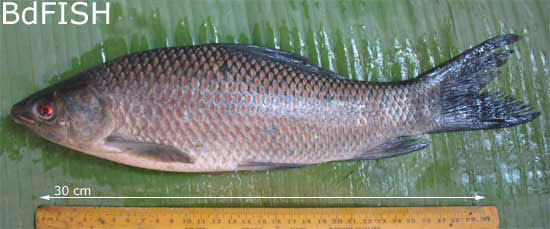
Synonyms:
Cyprinus calbasu Hamilton, 1822
Labeo calbasu Day, 1878
Labeo calbasu Shaw and Shebbeare, 1937
Common name: Kalbasu, Black rohu
Local name: Kalibaus, Baus, Kalia
Taxonomy position:
Phylum- Chordata
Class-Oesteichthyes
Order-Cypriniformes
Family- Cyprinidae
Genus-Labeo
Fin formula:
D. 17-18 (3/14-15); P1. 16-18; P2. 9 (1/8); A. 7(2/5). (Rahman, 2005)
Description of the species:
Dorsal profile is more convex than of abdomen. Lips thick, fringed. 2 pairs of barbells, rostal pair longer than maxillary pair (Rahman, 1989). No pores on snout. Eye situated a bit anterior from the half of the head (Bhuiyan, 1964). Caudal peduncle is short. Lateral line well marked, scales moderate in size. There are 20 rows of scales before dorsal fin and 22 rows round the caudal peduncle (Bhuiyan, 1964). Mouth is moderately wide and inferor. Gill openings wide snd gill rakers are villiform, short and feeble (Bhuiyan, 1964). Colour dark-black but the ventral part light dark. Ventral portion of the opercular region is white iris coppery. This fish attains a length of 90 cm (Talwar and Jhingran, 1991). Longest specimen in collection from Barnai river is 30 cm.
Habit and Habitat:
Generally it is a bottom feeder. It feeds on vegetable matter, crustaceans, insect larvae etc. Labeo calbasu feeds on algae 10%, higher plants 48%, protozoa 12%, crustacean 10%, mollusca 5%, mud and sand 15% (Bhuiyan, 1964). It does inhabit rivers and tributaries. They are also seen in deep pools clear sluggish streams, creeks. It can be reared in ponds and tanks (Bhuiyan, 1964 and Rahman, 1989).
Economic importance:
5.36g oil is found form 65 cm of its liver (Ghosh et.Al. 1933). Its liver oil contains Vitamin “A”. This fish is in great demand in the market. It is a good sport on rod and line.
Ecological role:
It also feeds on dead and decaying matter at the bottom; it acts as scavenger and improves the sanitation of the tank (Bhuiyan, 1964).
Status and conservation:
Available in Barnai river but listed in IUCN Red list as threatened (IUCN, 2000). Public awareness builds up and stopped destructive fishing method for conservation of the species.
References:
Bhuiyan, A. L. 1964. Fishes of Dacca. Asiatic Society of Pakistan, Dacca. 148 pp.
Day, F. 1878. Fishes of India, being a natural history of fishes known to inhabit the seas and freshwaters of India, Burma and Ceylon. William Dawson & Sons Ltd., London, Vol. I: p 536.
Ghosh, A.R., Chakravorty, P.N and Guha, B.C. 1933. Further Observations on Vitamis A in Indian Fish Liver Oils. Indian Journal of Medical Research, Calcutta. 21: p 441.
Hamilton, F., 1822. An account of the fishes found in the river Ganges and its branches, Edinburgh & London, Fishes Ganges, p 279.
IUCN Bangladesh. 2000. Red Book of Threatened Fishes of Bangladesh. IUCN- The World Conservation Union. xii+116 pp.
Rahman, A.K.A. 1989. Freshwater Fishes of Bangladesh. The Zoological Society of Bangladesh, Department of Zoology, University of Dhaka, Dhaka-1000. p 115.
Rahman, A.K.A. 2005. Freshwater Fishes of Bangladesh (Second edition). The Zoological Society of Bangladesh, Department of Zoology, University of Dhaka, Dhaka-1000. 394 pp.
Shaw and Shebbeare, 1937, The Fishes of Northern Bangal. Journal of Royal Asiatic Society of Bengal Science. p 22.
Talwar, P. K. and Jhingran, A. G., 1991. Inland Fishes of India and Adjacent Countries. Volume 1. Oxford & IBH Publishing Co. Pvt. Ltd. New Delhi, Calcutta. p 203.
Visited 19,013 times, 1 visits today | Have any fisheries relevant question?
